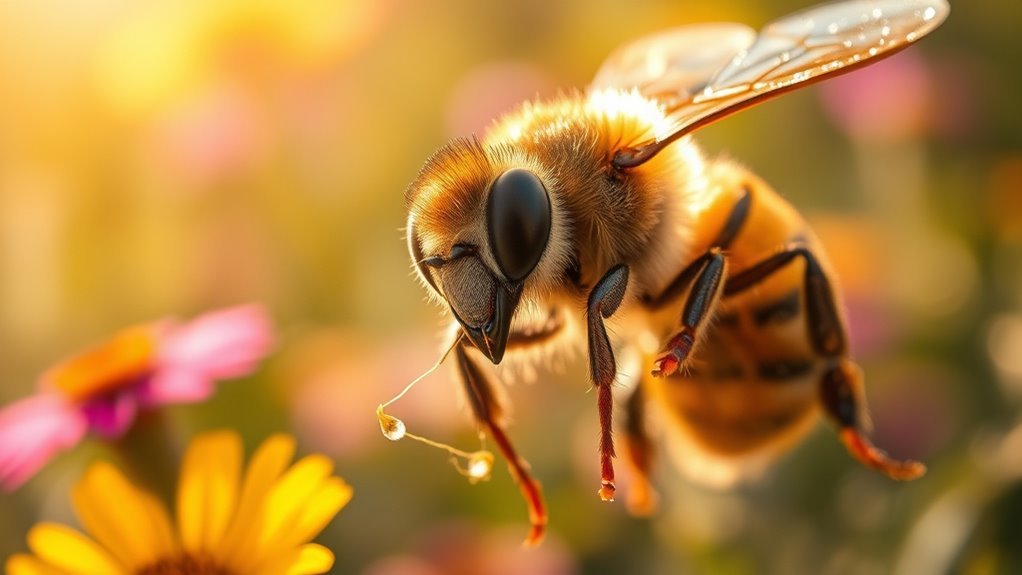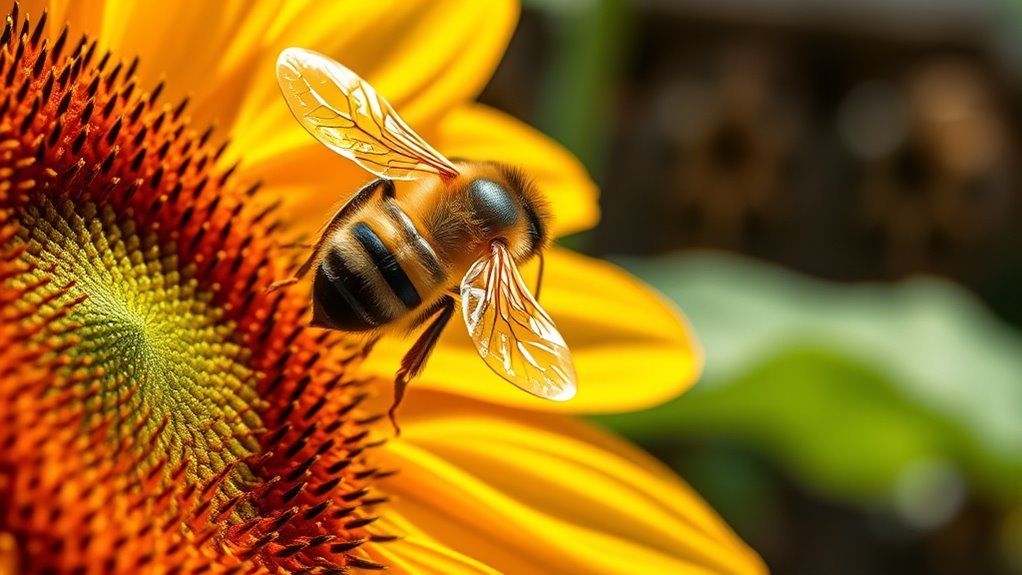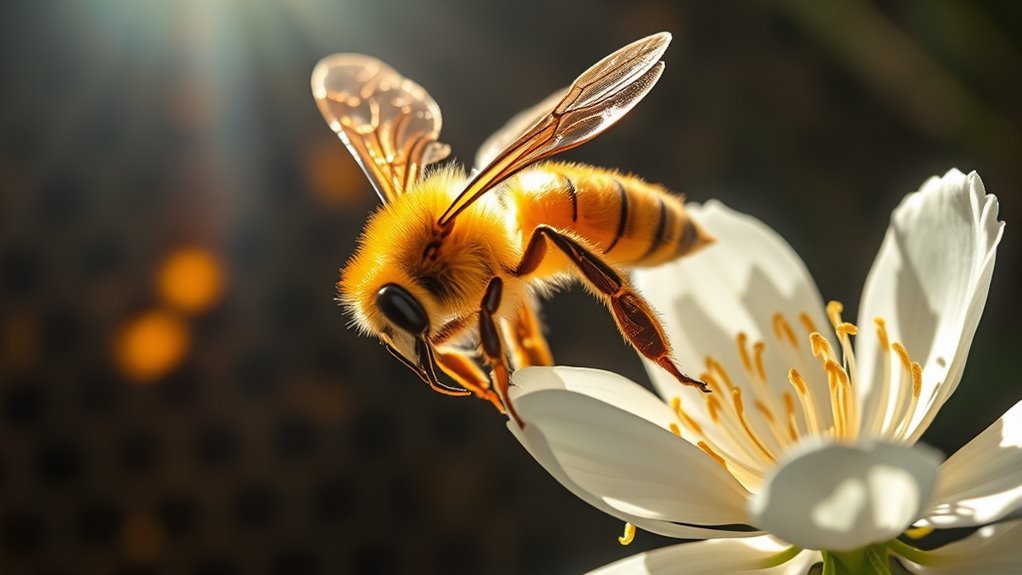Drone bees typically live for about eight weeks. Their short lifespan is largely due to their specific role in reproduction, with many dying shortly after mating. Factors such as nutrition, climate conditions, and predator presence can affect their survival rates. Unlike worker or queen bees, which have longer lifespans, drones face unique challenges that lead to their swift life cycle. Understanding these aspects reveals more about their ecological significance and contributions to the hive and environment.
Understanding Drone Bees

Drone bees, the male counterparts in a hive, play a vital role in the reproduction of honeybee colonies. Their behavior is distinctly defined by the hive hierarchy, where they occupy a unique position primarily focused on mating. Unlike worker bees, drones don’t participate in foraging or hive maintenance; their sole purpose is to mate with a queen during her nuptial flights. This behavior is essential for genetic diversity within the colony, as it guarantees the survival and adaptability of the hive. However, their presence is often seasonal, with drones being expelled from the hive in late autumn, highlighting their limited lifespan and role. Understanding this dynamic emphasizes the balance within the colony, showcasing nature’s intricate design and the importance of each caste.
The Life Cycle of a Drone Bee

The life cycle of a drone bee begins with its development from egg to adult, a process that typically spans several weeks. Initially, the fertilized egg, laid in a drone cell, develops into a larva, which feeds on royal jelly. As the larva matures, it undergoes significant changes in drone bee anatomy, including the formation of wings and reproductive organs. After pupation, the adult emerges, ready to fulfill its seasonal behavior, which is primarily focused on mating. Drone bees typically appear in late spring to summer, aligning their life cycle with the queen’s reproductive period. This synchronization guarantees their participation in mating flights, highlighting the intricate relationship between their life stages and the hive’s seasonal dynamics.
Role of Drone Bees in the Hive

Drone bees play a critical role in the hive, primarily through their involvement in the mating process with queens, which is essential for genetic diversity. This genetic variation is vital for the colony’s resilience and adaptability. Understanding the lifecycle and eventual death of drone bees also highlights their transient yet significant presence within the hive.
Mating Process Importance
While many aspects of a hive’s functionality depend on worker bees, the mating process involving drone bees plays an essential role in maintaining genetic diversity and colony health. Drone bees exhibit unique mating behaviors that are vital for successful reproduction. They engage in aerial mating flights, where they compete for the opportunity to mate with a queen. This competition is part of their reproductive strategies, ensuring that only the fittest drones contribute to the gene pool. By facilitating the union of genetic material from different colonies, drone bees help prevent inbreeding, which could compromise the hive’s resilience. Consequently, the mating process is not merely a biological function; it’s fundamental to the hive’s adaptive capabilities and overall stability in the ecosystem.
Genetic Diversity Contribution
Although often overlooked, drone bees play a critical role in enhancing the genetic diversity within a hive. This genetic variation is essential for the survival and adaptability of the colony. Here are three ways drone bees contribute to this diversity:
- Mating with Multiple Queens: Drones mate with queens from different hives, introducing new genetic material.
- Facilitating Evolutionary Advantages: Enhanced genetic diversity helps the colony adapt to environmental changes, disease resistance, and resource availability.
- Maintaining Hive Health: A genetically diverse population can reduce the likelihood of inbreeding, which can lead to vulnerabilities.
Lifecycle and Death
The role of drone bees extends beyond enhancing genetic diversity; it encompasses their lifecycle and eventual death within the hive. Drone bees, characterized by their distinct anatomy—larger eyes and robust bodies—are integral during mating seasons. Their seasonal behaviors are dictated by the queen’s reproductive cycle; they emerge in spring, aiming to mate with a virgin queen. However, a drone’s life is fleeting. After mating, they die almost immediately, while those that don’t mate face eviction from the hive in late autumn as resources dwindle. This cycle emphasizes the harsh realities of survival and reproductive success, reinforcing the hive’s efficiency. Understanding their lifecycle offers insight into the broader ecological roles drone bees play within their communities.
Factors Affecting Drone Bee Lifespan
Several factors greatly influence the lifespan of drone bees, which can vary based on environmental conditions, genetic predispositions, and colony dynamics. Understanding these influences helps you appreciate their delicate existence.
- Nutrition Availability: A rich diet supports drone development and enhances their reproductive success, while scarcity limits their lifespan.
- Climate Conditions: Extreme weather can act as an environmental stressor, impacting hive health and the overall longevity of drones.
- Predator Presence: The threat from predators increases mortality rates, affecting the drone population and their ability to mate successfully.
Seasonal changes also play a significant role, as drones are typically produced in warmer months and may struggle to survive in harsher climates. Each of these factors collectively shapes the life expectancy of drone bees.
Comparison With Worker Bees and Queen Bees
While drone bees play an essential role in the reproductive process of a hive, their lifespan contrasts sharply with that of worker bees and queen bees. Drone bees typically live for about eight weeks, primarily focusing on mating and exhibiting unique drone bee behavior, such as being fed and cared for by worker bees. In contrast, worker bees, which usually live for several weeks to a few months, engage in various tasks, including foraging and hive maintenance, contributing considerably to the hive’s overall functioning. Queen bees, the reproductive center of the hive, can live for several years, highlighting their crucial status in the hive hierarchy. This distinct disparity in lifespans reflects the different roles each type of bee plays within the colony’s ecosystem.
Mating Season and Its Impact on Lifespan
As drone bees approach mating season, their lifespan is greatly influenced by the urgency of their reproductive role. The seasonal timing of their emergence is critical, as it aligns with the queen’s mating flight. During this period, their mating behavior intensifies, but the stakes are high. Here are three key points to weigh:As mating season approaches, drone bees face a critical balancing act between reproduction urgency and lifespan.
- Urgency: Drones must mate quickly, as their lifespan can be drastically reduced after mating.
- Competition: Increased competition among drones further limits their lifespan, as only a few will successfully mate with a queen.
- Resource Allocation: Energy spent on mating behaviors can detract from other survival activities, ultimately shortening their lives.
Understanding these dynamics sheds light on the delicate balance between reproduction and longevity in drone bees.
Environmental Influences on Drone Bee Survival
Environmental factors play an essential role in determining the survival rates of drone bees, influencing their health and longevity in significant ways. Climate change poses a serious threat, altering flowering patterns and food availability, which directly affects drone nutrition and reproductive success. As temperatures rise and weather patterns shift, drone bees may find it challenging to adapt, leading to increased mortality. Additionally, habitat loss due to urbanization and agricultural expansion diminishes the environments fundamental for foraging and nesting. These changes disrupt the delicate balance of ecosystems where drone bees thrive. Consequently, understanding these environmental influences is imperative in developing strategies to foster bee populations, ensuring that these crucial pollinators can continue to flourish despite the mounting challenges they face.
The End of a Drone Bee’s Life
Although drone bees play a vital role in the reproductive cycle of their colonies, their life spans are particularly short, typically lasting only a few weeks to a few months. The end of a drone bee’s life is influenced by several lifespan factors, including:
- Mating Success: Drones that successfully mate with a queen may die shortly after, as their reproductive organs are removed.
- Colony Dynamics: During the fall, colonies may expel drones to conserve resources, leading to their demise.
- Environmental Conditions: Factors like temperature and food availability can greatly affect drone bee behavior and overall lifespan.
Understanding these factors helps clarify the relatively brief existence of drone bees and their essential, yet ephemeral, role in the hive.
Importance of Drone Bees in Ecosystems
Drone bees play an essential role in ecosystems primarily through their contributions to pollination, which affects plant reproduction and biodiversity. Additionally, they enhance genetic diversity within bee populations, fostering resilience against diseases and environmental changes. Their influence on hive dynamics also guarantees colony stability and productivity, underscoring their importance in maintaining healthy ecosystems.
Pollination Contribution
In ecosystems, the role of drone bees in pollination is often underestimated, yet they contribute considerably to genetic diversity and the overall health of plant communities. Their impact on pollination efficiency and ecosystem balance is significant. Here are three key contributions:
- Mating with Queen Bees: Drone bees fertilize queen bees, ensuring a diverse gene pool that promotes resilience in plant species.
- Assisting Worker Bees: Their presence supports worker bees in foraging, thereby enhancing overall pollination rates across various flora.
- Facilitating Cross-Pollination: By visiting multiple flowers, drone bees help in cross-pollination, boosting genetic interchange and plant vitality.
Understanding these contributions highlights the crucial role drone bees play in maintaining ecosystem functionality and diversity.
Genetic Diversity Role
The genetic diversity within ecosystems relies heavily on the role of drone bees. These male bees contribute to genetic variation, which is essential for maintaining robust populations. By mating with queens, drone bees guarantee the transfer of diverse genetic material, enhancing the resilience of hives against diseases and environmental challenges. This genetic variation directly impacts hive health, as it fosters the development of traits that improve survival and adaptability. When a hive has a healthy genetic mix, it can better withstand stressors, leading to more stable and productive colonies. Fundamentally, drone bees play a significant role in sustaining biodiversity, which supports not only their own survival but also the broader ecosystem in which they exist.
Hive Dynamics Influence
While it might seem that worker bees dominate hive activities, drone bees serve an important role in the overall dynamics of the colony. Their presence influences both hive hierarchy and drone behavior in significant ways. Understanding their contributions can enhance your appreciation of these essential insects:
- Reproduction: Drones are important for mating with queens, ensuring genetic diversity and the colony’s long-term survival.
- Resource Management: Drones assist in foraging activities, indirectly supporting worker bees in resource allocation and hive maintenance.
- Social Structure: The presence of drones helps reinforce social order within the hive, impacting the behaviors of workers and the queen.
Recognizing these roles underscores the significance of drone bees in maintaining ecosystem balance, emphasizing their value beyond mere reproduction.
Frequently Asked Questions
Do Drone Bees Have Any Natural Predators?
Drone bees face various natural threats, including birds, wasps, and other predatory insects. These predators can markedly impact drone populations, emphasizing the delicate balance in ecosystems where drone bees play an essential role.
Can Drone Bees Survive Outside the Hive?
Did you know that drone bees can only survive a few hours outside the hive environment? Their survival is intricately tied to the hive, as they rely on it for warmth and protection from predators.
How Do Drone Bees Communicate With Each Other?
Drone bees communicate primarily through pheromones, influencing drone behavior and hive dynamics. These chemical signals help establish hierarchy, mating readiness, and overall cohesion within the hive, ensuring the colony functions effectively and harmoniously.
What Do Drone Bees Eat During Their Life?
Drone bees primarily consume honey and pollen, utilizing hive resources for their nutrition. This diet supports their development and energy needs, essential for mating flights, reflecting the intricate balance of resources within the hive ecosystem.
Are Drone Bees Affected by Pesticides?
When considering bee health, it’s essential to recognize that drone bees, like all bees, suffer from pesticide exposure. These chemicals compromise their immune systems, ultimately threatening the entire hive’s survival and the ecosystem’s balance.

